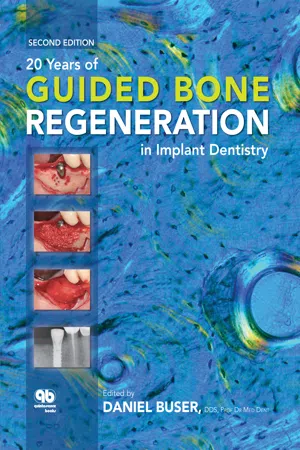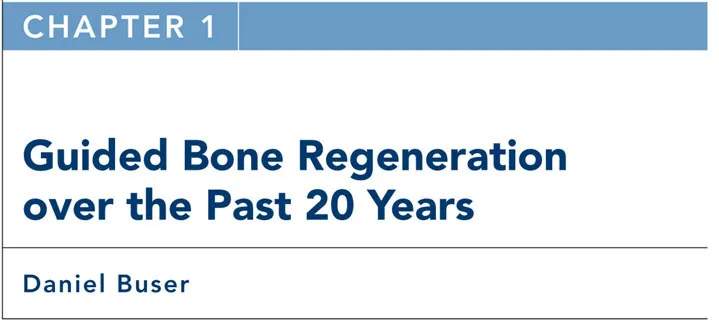![]()
Based on fundamental experimental studies performed by the research teams of Per-Ingvar Brånemark from the University of Gothenburg (Sweden) and André Schroeder from the University of Bern (Switzerland), the use of dental implants has become a scientifically accepted treatment for the replacement of lost or missing teeth in fully and partially edentulous patients. In landmark papers published in the late 1960s and 1970s, both research teams described the phenomenon of osseointegrated titanium implants.1–3 An osseointegrated implant is characterized by direct apposition of living bone to the titanium surface.4,5
Several prerequisites have been defined for achieving osseointegration of titanium implants with high predictability.1,2 Some of these have been revised over the past 30 years; others are still considered important. To achieve osseointegration, the implant must be inserted with a low-trauma surgical technique to avoid overheating of the bone during preparation of a precise recipient site, and the implant should be placed with sufficient primary stability.6 When these clinical guidelines are followed, successful osseointegration will predictably occur for nonsubmerged titanium implants (single-stage procedure) as well as for submerged titanium implants (two-stage procedure), as demonstrated in comparative, experimental studies.7,8
When clinical testing of osseointegrated implants first began, the majority of treated patients were fully edentulous. Promising results were reported in various retrospective studies.9–13 Encouraged by these good treatment outcomes, clinicians started to utilize osseointegrated implants in partially edentulous patients, and the first reports of promising short-term results were published in the late 1980s and early 1990s.14–18 As a consequence, single-tooth gaps and distal-extension situations have become more and more common indications for implant therapy in daily practice, and today these applications dominate in many clinical centers.19
One of the most important prerequisites for achieving and maintaining successful osseointegration is the presence of a sufficient volume of healthy bone at the recipient site. This includes not only bone of sufficient height to allow the insertion of an implant of appropriate length but also a ridge of sufficient crest width. Clinical studies have shown that implants placed in a site with a missing buccal bone wall have a greater rate of soft tissue complications20 and/or a compromised long-term prognosis.21,22 To avoid increased rates of implant complications and failures, these studies suggested that sites with inadequate bone volume either should be considered local contraindications to implant placement or should be locally augmented with an appropriate surgical procedure to regenerate the bone and allow implant placement.
In the 1980s and early 1990s, several attempts were made to develop new surgical techniques to augment bony defects in the alveolar ridge to overcome these local contraindications to implant-borne prostheses. The proposed techniques included vertical ridge augmentation with autogenous bone grafts from the iliac crest in extremely atrophic mandibles or maxillae,23,24 sinus floor elevation procedures in partially or fully edentulous maxillae,25–27 the application of autogenous onlay grafts for lateral ridge augmentation,28–30 or split-crest techniques, such as alveolar extension plasty.31–33
During the same period, in addition to these new surgical techniques, the concept of guided bone regeneration (GBR) utilizing barrier membranes was introduced. Based on case reports and short-term clinical studies, various authors reported first results with this membrane technique for the regeneration of localized bone defects in implant patients.34–39
This textbook provides an update on the biologic basis of the GBR technique and its clinical applications, predominantly in partially edentulous patients. Clinical experience with GBR in implant patients now spans 20 years. These 20 years can be divided into a development phase and a phase of routine application.
Development Phase
The utilization of barrier membranes for implant patients was certainly triggered by the clinical application of barrier membranes for periodontal regeneration, called guided tissue regeneration (GTR). GTR was first developed in the early 1980s by Nyman et al.40,41 The initial studies were made with Millipore filters (Millipore), which had already been used in the late 1950s and 1960s for the regeneration of bone defects in experimental studies.42–44 However, these studies had no impact on the development of new surgical techniques to regenerate localized defects in the jaws because the potential of this membrane application probably was not recognized.
The articles by Nyman et al40,41 in the field of GTR, both of which demonstrated successful treatment outcomes of GTR procedures, created a great deal of interest and led to much research activity in the mid- to late 1980s.45–48 These studies were performed with expanded polytetrafluoroethylene (ePTFE), which is a bioinert membrane and became the standard membrane for GTR and GBR procedures during the development phase of both techniques. The use of ePTFE membranes for bone regeneration was initiated in the mid-1980s by the group led by Nyman and Dahlin, who performed a series of experimental studies.49–51 These studies confirmed the concept that the application of an ePTFE membrane creates a physical barrier that separates the tissues and cells that could potentially participate in the wound healing events. The barrier membrane creates a secluded space and facilitates the proliferation of angiogenic and osteogenic cells from the marrow space into that defect without interference by fibroblasts. These events were nicely demonstrated by Schenk et al52 in a landmark experimental study in foxhounds. The current understanding of wound healing events in membrane-protected bone defects are presented in chapter 2.
The utilization of ePTFE membranes for GBR procedures in patients started in the late 1980s. The main objective was to regenerate peri-implant bone defects in implant sites with local bone deficiencies. The GBR technique has been used with a simultaneous or a staged approach.35 Implant placement with simultaneous GBR was predominantly used for immediate implant placement in postextraction sites to regenerate peri-implant bone defects34,37 or for implants with crestal dehiscence defects.39 The staged approach was used in clinical situations with healed implant sites but an insufficient crest width. The membrane technique was utilized to enlarge the crest width with a first surgery, and implant placement took place in a second surgical procedure performed after 6 to 9 months of healing.36
Early on, several complica...

